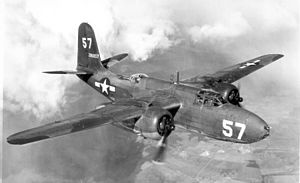Douglas A-20 Havoc
| A-20 Havoc DB-7/Boston/P-70 |
|
|---|---|
 |
|
| A-20G of the USAAF | |
| Role | Light bomber |
| Manufacturer | Douglas |
| Designer | Ed Heinemann |
| First flight | 23 January 1939 |
| Introduction | 10 January 1941 |
| Retired | (USAF) 1949 |
| Primary users |
United States Army Air Forces Soviet Air Force Royal Air Force French Air Force |
| Produced | 1939–1944 |
| Number built | 7,478 |
| Developed into | Douglas DC-5 |
The Douglas A-20 Havoc (company designation DB-7) was an American attack, light bomber, intruder aircraft of World War II. It served with several Allied air forces, principally the United States Army Air Forces (USAAF), the Soviet Air Forces (VVS), Soviet Naval Aviation (AVMF) and the Royal Air Force (RAF) of the United Kingdom. Soviet units received more than one in three (2,908 aircraft) of the DB-7s ultimately built. It was also used by the air forces of Australia, South Africa, France, and the Netherlands during the war, and by Brazil afterwards.
In British Commonwealth air forces, bomber/attack variants of the DB-7 were usually known by the service name Boston, while night fighter and intruder variants were usually known as Havoc. An exception to this was the Royal Australian Air Force, which referred to all variants of the DB-7 by the name Boston. The USAAF referred to night fighter variants as P-70.
In March 1937, a design team headed by Donald Douglas, Jack Northrop and Ed Heinemann produced a proposal for a light bomber powered by a pair of 450 hp (336 kW) Pratt & Whitney R-985 Wasp Junior radial engines mounted on a shoulder wing. It was estimated that it could carry a 1,000 lb (454 kg) bomb load at 250 mph (400 km/h). Reports of aircraft performance from the Spanish Civil War indicated that this design would be seriously underpowered, and it was subsequently cancelled.
...
Wikipedia
